
Introduction and design
In recent years, the predominant tablet trend has been towards compact ones such as the iPad mini 2, the Google Nexus 7, and the Amazon Kindle Fire HDX 7. Now, with Apple’s much-rumoured iPad maxi on the horizon, a new craze for super-sized tablets could be set to take hold.
With Samsung yet to launch a wholly convincing compact tablet of its own, it will be hoping to get a strong foothold in the fledgling maxi-tablet category with the Samsung Galaxy Note Pro 12.2.
This is a formidable tablet in every way, with a premium spec sheet and an extensive list of software features that those familiar with the Note series will already be aware of.
As well as that 12.2-inch 2560 x 1600 display, Samsung has gone big on specs. Sporting a custom 1.9GHz quad-core Exynos CPU, 3GB of RAM, 32GB or 64GB of internal storage, 8MP rear camera and Samsung’s integrated S Pen stylus, it’s one of the best-equipped tablets I’ve ever used.
Of course, with a launch price of around £649 ($850, which is around AU$940), you’d damned well expect such class-leading components.

That price places it somewhere in between the 128GB iPad Air at £639 and the 64GB Microsoft Surface Pro 2 at £719. Or, to put it another way, the best model of the best tablet ever and the most powerful tablet ever.
No pressure, then.
Samsung is clearly aiming for the same premium-business end of the market as those two elite tablets. Let’s see if it’s managed to close the deal.
Size isn’t everything
You know those tablet and smartphone reviews where the writer says that a device is deceptively large, and doesn’t feel as big and bulky as it is on paper? This isn’t going to be one of those reviews.
Make no mistake, you feel every one of the Samsung Galaxy Note Pro 12.2’s extra 2.1 inches when you hold it in your hands or – as is more likely – prop it on your lap.
I was quite taken aback by just how broad it feels. It’s almost more like holding a small PC monitor than a tablet, despite being just 8mm thick.

That vast expanse of glass takes its toll on your wrists, too. Weighing in at 753g, the Galaxy Note Pro made my chunky iPad 3 feel light. With a difference of 100g, it’s plain to see how.
This actually forces you to modify how you hold and use the tablet. If you like to support a tablet in one hand while using the other to interact with the screen, well, that’s not going to be possible here. Not over an extended period, at least.

You’ll want to prop the Galaxy Note Pro 12.2 on a table or wedge it on your lap. This isn’t necessarily a problem, just as it’s not a problem that you can’t quite view full websites comfortably on a 7-inch tablet.
It’s a byproduct of the design. But you should know that this isn’t a tablet that you’ll want to take out with you and whip out at a bus stop or cafe.
Samsung has stuck with the design approach it took with the Samsung Galaxy Note 3 and the Samsung Galaxy Note 10.1 2014. You get the same glass-covered front, the same metallic-looking (but defiantly plastic) outer rim, and the same slightly tacky (but reassuringly grippy) faux-leather back covering.

Samsung’s typically iffy design is ever so slightly tougher to swallow here given the above-premium price tag – especially when held against those aforementioned premium rivals, the iPad Air and the Surface Pro 2.
What’s more, the added size and heft makes the Galaxy Note Pro 12.2 feel less solid structurally, with added flex and audible creaking when the unit is gripped and twisted.
Port and button placement is also standard Samsung issue, for the most part. You get that familiar lozenge-shaped physical home key right below the screen, flanked by capacitive multi-tasking and back-up keys.
More and more manufacturers are moving over to Google’s buttonless approach, but there’s still something to be said for the surety of a good set of physical controls.

Like the Galaxy Note 10.1, the power button and volume rocker are quite flat and situated on the top edge, right near the left hand corner. This is assuming you’re holding the Galaxy Note Pro 12.2 in landscape mode, as intended.
I would have liked these controls to be slightly more defined, but their location makes them easy enough to find in a pinch.
To the right of these buttons is an IR LED, which allows the use of the tablet as a universal remote control with a handy piece of included Samsung software called WatchON.
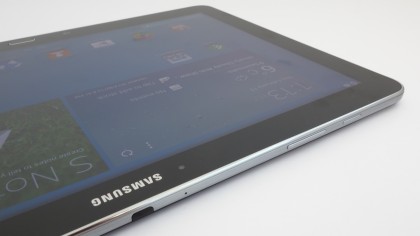
The one major change here when compared to the Galaxy Note 10.1 is actually a very thoughtful one. Samsung has relocated the microUSB to the right hand side, alongside the microSD hatch (which allows for up to 64GB of additional storage).
This leaves the bottom of the Galaxy Note Pro 12.2 completely free of controls and ports. As I mentioned, you’ll be propping this tablet up an awful lot more than with smaller tablets, so anything you need to access here would inevitably lead to annoyance and discomfort. Smart move, Samsung.
Going back to that microUSB port, you’ll notice that it looks a little different to that of most other Android devices. That’s because it’s actually a microUSB 3.0 port, which resembles previous versions, but with an extra component to the side. You can still use your existing phone or tablet charger with it, but it will take much longer to charge.

The new standard also boosts file transfer speeds when hooked up to your PC, provided you have a USB 3.0 port handy.
Also well placed is the Samsung Galaxy Note Pro 12.2’s camera. By positioning it at the top and centrally on the rear of the tablet, it means your fingers won’t be anywhere near it when you pull the trigger. Or rather, push the virtual shutter button.
Key features
Function over form
Without doubt the Samsung Galaxy Note Pro 12.2’s defining feature is its massive 12.2-inch display. It fundamentally enhances basic tablet tasks like web browsing and video watching.
At a base technical level, the screen is reasonably impressive. Its 2560 x 1600 resolution is the same as the latest Samsung Galaxy Note 10.1‘s, which makes for a generally crisp picture.
Of course, this is stretched over a much broader canvas, so images and text don’t seem to be quite as sharp as you might be used to.

The larger screen also magnifies the slight fuzziness that comes as a side effect with all PenTile panels. More commonly associated with Samsung’s AMOLED displays, the PenTile configuration incorporates white sub-pixels for greater power-efficiency and brightness, but at the cost of a little image clarity, which is especially noticeable on white areas and text.
Held at arms length, though, you probably won’t notice much of this, and that extra brightness certainly helps images to pop.
Not just a pen
This 12.2-inch display also hooks up superbly with another of the Galaxy Note Pro 12.2’s key features. Put simply, this is the best realisation of the S Pen concept I’ve seen yet.
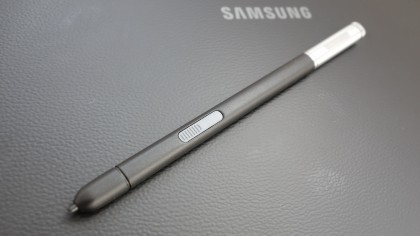
S Pen, in case you haven’t encountered it before, is a rubber-tipped plastic stylus that allows you to draw or write on the tablet’s display, leading to various applications linked to naturalistic handwriting and pin-point navigation.
When using the S Pen, the screen stops registering contact with your hand, allowing you to lean on the tablet and to ‘write’ naturally.
It’s not that Samsung has done anything particularly new or different with its stylus, which is housed in the top right hand edge of the device. It’s the same experience as can be found in the Galaxy Note 10.1.

But with the extra screen space, suddenly you have the kind of blank canvas that such a concept deserves.
You can apply the canvas expression quite literally with the excellent SketchBook app, which finds its natural home here. This intuitive art app allows you to create genuinely excellent pictures – provided you have considerably more artistic talent than I do, of course.

As well as the usual range of pen and paint options, there are multiple layers to play with. The S Pen can also detect the amount of pressure you’re putting on the screen, adjusting the forcefulness of a virtual pencil stroke accordingly.
Examples of the S Pen coming into its own on the Galaxy Note Pro 12.2 abound elsewhere, such as when hovering the stylus over an image thumbnail in the gallery to bring up a preview.
That preview is appreciably larger than before, which means that it’s actually useful for reviewing your images, rather than simply being a cool gimmick. You can also access editing options by clicking the S Pen button on these previews.

As before, the S Pen has its own button which, when pressed while hovering near the screen, brings up the Air Command menu. Through this you can do things like create virtual post-it notes for sticking to your home screen.
Samsung’s powerful handwriting recognition software means that you can scribble down an address in this Action Memo mode and have it recognised and decoded as such in Google Maps. It’s similarly intelligent when it comes to phone numbers.

Scrap Booker is particularly well suited to the Galaxy Note Pro 12.2’s large screen. It lets you draw around sections of the current display in order to copy and save them as image snippets for later reference – yep, just like a scrapbook.

Screen Write uses a similar principle, grabbing a complete screenshot and allowing you to annotate it with the S Pen.
All in all, while the Samsung Galaxy Note Pro 12.2’s large display is the headline grabbing new feature, it’s the proper realisation of a pre-existing one that really deserves the plaudits.
Interface and performance
I’ve never been the biggest fan of Samsung’s approach to Android, finding it to be weighed down with unnecessary features and more than a little gaudy. But the software found on the Samsung Galaxy Note Pro 12.2 represents a notable improvement.
It’s running the latest iteration of Android, version 4.4.2 KitKat, but that’s not the important part. Far more noteworthy are the changes Samsung has made to its overlying TouchWiz UI.

While I still prefer good old stock Android, Samsung’s modified effort is more streamlined and pleasant to use than that of previous devices such as the Samsung Galaxy Note 10.1. There are just two standard home screens, containing a couple of the usual Samsung widgets (which can, of course, be removed).
Meanwhile, Google Search and the app tray commands have been situated in bottom left and bottom right hand corners of the two main home screens respectively, providing quick thumb access without taking up too much space.

More interesting here is the fact that Samsung has also developed the My Magazine section from the previous version of TouchWiz into a more integrated element. This means that it can be accessed with a lateral swipe, like an additional home screen (or two), rather than the counter-intuitive and tacked-on upwards swipe of before.
It sounds like a minor thing, but with this simple streamlining effort I found myself ‘running into’ the Magazine UX feature far more, which led to it being adopted into my daily usage.
Magazine UX is a Flipboard-like aggregator that pulls together news stories, social network updates, and commonly used applications into an image-heavy magazine format.

One of these pages, by default, pulls together your latest emails, offers a calendar view, and allows you to make quick additions to the S Planner schedule organiser app.
There’s also a business-oriented news story pane and one for Hancom Office – an included office document application.
Tapping on any of these elements opens an expanded version, whether that’s the Flipboard app, your email, or whatever the source is.
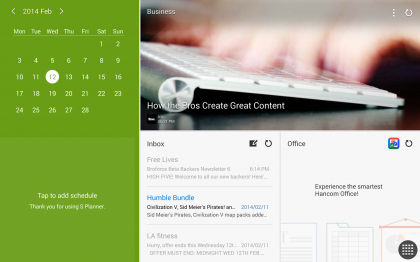
Back to the main interface, and Samsung has also significantly improved the notification menu. Gone are the ugly and excessive control shortcuts and the needlessly screen-width notifications.
In their place is a neat, centrally situated drop-down menu with clearly demarcated settings controls for Wi-Fi, screen brightness and the like, as well as the latest sensibly proportioned notifications.
It’s worth noting again that Android handles notifications better than any other mobile OS. Emails offer a preview of the message and the ability to reply, images feature instant sharing and edit options, and Google Now notifications keep you abreast of everything from football scores to flight times.

Of course, this is all present in other Android devices, but Samsung should be commended for restraining its usual urge to over-elaborate, and for letting Android’s solid core shine through a little more.
Like I said, I’d still prefer the fully customisable, stripped-back interface of stock Android over this, but Samsung has made some commendable strides forward with its latest round of UI pimping.
General performance when navigating through these home screens on the Samsung Galaxy Note Pro 12.2 is strong, if nothing especially impressive.
I still detected the odd stutter and pause from time to time when transitioning between menus, but this has long been established as a software matter rather than a hardware one. No mainstream custom UI runs as smoothly as stock Android, and even Google’s fine OS has its moments (though far fewer than it used to).
On the matter of hardware, my GeekBench 3 tests revealed single and multi-core performance that was near the top of the Android tree, alongside its brothers the Samsung Galaxy Note 3 and the Samsung Galaxy Note 10.1. Which, when you consider that it’s running on the same Exynos 5 chip, is unsurprising.

The extra headroom afforded by the Galaxy Note Pro 12.2’s 3GB of RAM doesn’t manifest itself here, perhaps, but it does make the process of opening multiple app windows feel slick.
By dragging from the right of the screen, you open a menu containing all of the apps with window support. Touch the app icons and they’ll open up in a small window, each around a quarter to a third of the size of the screen.
You can open up to five apps simultaneously in this way and switch between them with a touch – much like you would on a computer.

Except, it’s not nearly as intuitive as on a computer. These windows sit awkwardly with regular tablet functionality, obstructing your view more often than not.
Touching on the full-screen application or home screen in the background doesn’t snap it to the fore, as you might expect, meaning you have to minimise or clear each windowed task individually.
Much handier is the multi-window view, which Samsung has neatly pulled into this same menu. By dragging the app icons onto the main screen, you’ll open them up in a fixed sector of the screen.
You can have up to four apps running simultaneously, each with their own dedicated (and fully resizable) quarter.
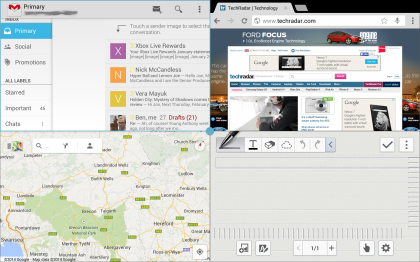
This was a neat feature in previous Samsung devices, but again it finds a new level of usefulness here on the 12.2-inch display. Each app quarter is about the size of a large (if somewhat squarer-than-usual) Android phone, making each eminently usable.
Performance is excellent here – I was able to scroll around the country in Google Maps whilst loading the TechRadar home page and playing a YouTube video, with only a slight degradation of performance.
To the casual user this will no doubt be a nice but seldom-used gimmick, but the ability to have S Note, Gmail, a calculator and a web page (for example) open and within view simultaneously has undoubted benefits for power users. And that’s precisely who the Samsung Galaxy Note Pro 12.2 is aimed at.
Battery life and the essentials
Battery life
Samsung has fitted the Galaxy Note Pro 12.2 with a much larger battery than the next model down in the range, the Samsung Galaxy Note 10.1 2014.
Out goes that tablet’s 8220mAh unit (which is hardly what you’d call small) and in goes a whopping 9500mAh example. Just to put that into context, the iPad Air features an 8820mAh battery.
Of course, the reason for this is Note Pro 12.2’s unusually large display. A tablet’s screen is by far the biggest source of power drain, so adding inches shortens battery life significantly.
Thanks to that large power plant, however, the Galaxy Note Pro 12.2 lasts as long as smaller tablets. With the screen brightness cranked up to maximum, I got around two days of medium to heavy usage out of a single charge.

This included installing a number of apps, watching some HD video samples, playing several games (some of which employed high-end 3D graphics), plenty of web surfing, and testing the Galaxy Note 12.2’s multi-app abilities.
Drop the brightness down to around two thirds to a half, which is still perfectly usable with this tablet, and you should be able to exceed that.
I also ran the Samsung Galaxy Note Pro 12.2 through TechRadar’s standard HD video test, which involves playing a 90-minute 720p video with the screen brightness cranked right up.
This resulted in an average remaining battery life of 72%, which is at the lower end of normal for a top-end tablet. It’s also slightly better than I managed with the Galaxy Note 10.1 2014.
The essentials
The Samsung Galaxy Note Pro 12.2 runs very similarly to any other Android tablet, but the sheer size of the screen, married to its high-end specs, make many regular tasks feel a little different.
Typing using Samsung’s own virtual keyboard, for example, has never been easier. The keys take up the entire bottom half of the screen, and are significantly larger than on even Samsung’s 10-inch tablets, boosting accuracy. Dedicated numerical keys are as welcome as ever.
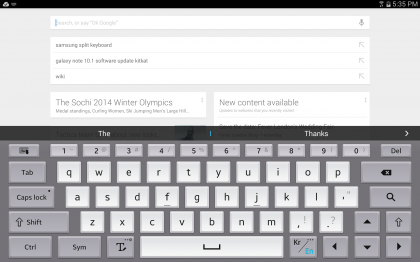
Of course, you’ll have to type two-handed, so there’ll be plenty of instances of being hunched over your lap or looking for a nearby flat surface.
It’s a shame there’s no split keyboard option for the default Samsung keyboard, as with the likes of SwiftKey, in order to give you an option to type while holding the Galaxy Note Pro 12.2 in a two-handed grip.
General web browser performance is no quicker than any other high-end tablet, but you do, of course, get to see web pages in close to their full glory. While the ‘blown up’ effect exposes the blurry edges on some websites, the general effect is as close to a desktop experience as I’ve come across.
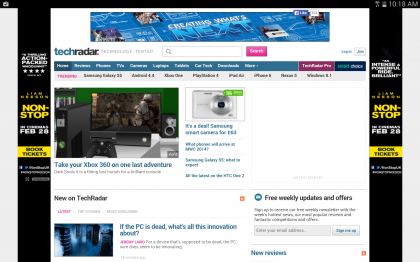
I’m still not sure why Samsung insists on including both Chrome and the old stock Android browser, though. Seriously, guys – stick with Chrome and drop the Internet app. I don’t need both.
Perhaps the most surprising beneficiary of the Samsung Galaxy Note Pro 12.2’s extra girth is its sound quality. The stereo speakers are well positioned and decent by mobile standards (if lacking in low-end bass), as they were on the Galaxy Note 10.1, but the extra degree of physical separation leads to a more pronounced stereo effect than you might be used to.
Boot up Plants vs Zombies 2, for example, and you can discern clearly the sounds of your plant defences to the left and the shuffling, groaning hoards of the undead to your right. I was genuinely impressed.

Of course, as I’ve already mentioned, the Galaxy Note Pro 12.2 is a business-oriented tablet first and foremost, and it’s got the software to prove it.
Samsung Knox allows you to set up a completely separate home screen environment on the tablet, which will be of extreme interest to those with particularly jittery or security-conscious IT departments who might be anxious to keep your personal web browsing and app downloading completely separate.
Meanwhile, the Cisco WebEx app allows you to create and join online virtual meetings from the tablet, while Samsung e-meeting helps with local meetings, letting you share content without the need of a network connection.
Camera and media
Anyone who uses a tablet as their everyday camera is either ignorant or a bit of a wally. Your average smartphone camera is both better and more easy to wield.
The Samsung Galaxy Note Pro 12.2 is a tablet of extremes in this regard. You’ll never look more ridiculous taking pictures with a tablet than you will with this huge, flat slab of plastic. It’s beyond comical, and prompted me to carefully seek decent snapping opportunities well away from public eyes.
On the other hand, there aren’t many tablet cameras that are as accomplished as this one. It seems to be a similar 8MP example to the one found on the latest Galaxy Note 10.1, which I was quite impressed with.
This means that you get uncharacteristically sharp and vibrant snaps in good natural lighting, and adequate (if slightly grainy) images in inside and low-light conditions. There’s even a flash here, which you don’t always get with tablets.
As with the Galaxy Note 10.1, you actually get 6MP images by default, with a 16:9 ‘HD’ aspect ratio. Bumping this up to the full 8MP setting forces things to old fashioned 4:3.
![]()
Samsung has included a number of features that help to enhance smartphone photography, but which don’t always make their way (successfully at least) into tablets.
The HDR mode does well at improving those scenes containing deep contrasts between light and shade, while there’s an anti-shake facility for helping to improve low light shots. Just don’t let the subject move around.
You can even get a pretty decent depth of field effect when shooting macro-like close-ups.
Actual shot times are extremely impressive, with virtually no lag between the time you press the virtual shutter button and the shot being taken.
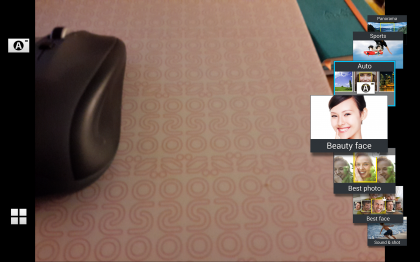
The camera interface, meanwhile, continues to impress, with a huge range of shooting modes and tweakable settings. Aside from the obvious ‘Panorama’, you get a ‘Beauty face’ mode for that unnatural catalogue model effect, ‘Best photo’ for taking multiple pictures and selecting the best, and ‘Best face’ for a similar feature that merges group shots.
‘Sound & shot’ is a bit of a gimmick, as it adds a snippet of sound from the environment at the time of the shot, but ‘Drama’ is pretty effective at portraying action by layering multiple images over a fixed background. And there are more.
Video is shot at full 1080p, as you might expect, and it’s perfectly adequate if you can keep the tablet fairly still.
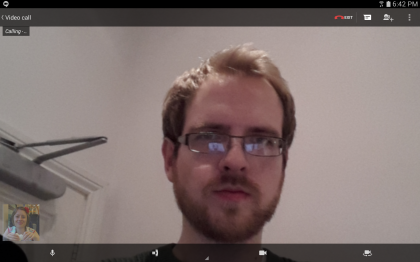
The Galaxy Note Pro 12.2’s front camera is a 2MP unit, which is fairly generous for a tablet – the iPad Air’s, for example, is only 1.2MP.
As you’re more likely to use this camera than the main one, that’s an important spec. Image quality on video calls is fine, if typically fuzzy around the edges.

Click here to view the full resolution image

Click here to view the full resolution image

Click here to view the full resolution image

Click here to view the full resolution image

Click here to view the full resolution image
Media
While the Samsung Galaxy Note Pro 12.2 is undoubtedly aimed at the business-led end of the market, it’s also one of the finest media-playing Android tablets around.
The sheer size of that 12.2-inch display makes watching films and videos feel like a full-fat experience – although it also serves to expose lower quality footage. Anything below 1080p feels noticeably grainy here.
As I’ve already mentioned, the Galaxy Note Pro 12.2’s speakers are loud and clear, and provide excellent stereo separation.
This makes them excellent for playing brief videos out loud, but the lack of bass means that they’re not brilliantly suited to films or music. As always, I’d recommend investing in a decent set of headphones.

In terms of the media itself, you’re well served by Google’s default offerings on the Google Play Store. The roster of movies and TV shows is comprehensive and competitively priced (new films are around £3.49 in SD or £4.49 in HD), but Samsung’s own media store, Samsung Hub, is entirely superfluous.
It offers a similar selection of films for similar prices, but with a much less attractive interface. Plus, you won’t be able to carry your media content across to anywhere near as many devices as you can when you obtain it through Google.
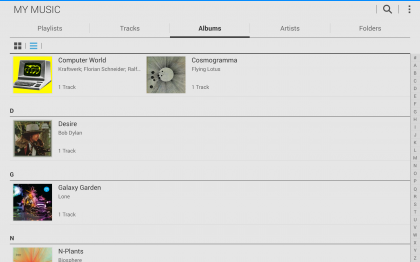
Strangely, on the music side, Samsung hasn’t included the comprehensive Google Music app as standard. All you have is Samsung’s own anaemic Music app, which lets you play locally stored MP3s and not a lot else, and the aforementioned Hub store.
Once underway, the music control options are neatly handled, with a little music bar below the toggles in the notification menu and a compact lock screen widget. But I’d recommend downloading Google Music and making that your all-round music player of choice.
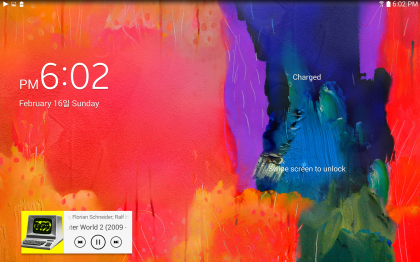
I’ve also hinted at gaming on the Galaxy Note Pro 12.2. It’s a strong performer, with Samsung’s latest Exynos processor (and accompanying GPU) one of the strongest around.
Playing Dead Trigger 2 with the graphics settings bumped up to high posed no problems for the tablet, and really showed off the console-style first person shooter to its full potential.

Meanwhile, strategy games that typically require a lot of screen panning and zooming, such as Swords and Soldiers and Royal Revolt, play better here than on any other tablet.
When it comes to storing all of this media, you’re well served with the Galaxy Note Pro 12.2. As stated, you get either 32GB or 64GB of internal storage, plus a microSD for up to 64GB extra.
On top of that, Samsung also includes tight integration with Dropbox, which can be established during the initial set-up process. You get 50GB of free storage for two years, and Samsung’s Gallery app will pull in your Dropbox-stored images as standard.
It’s a simple matter of clicking yes during set-up to automatically upload any pictures taken on the tablet to the service.
Comparisons
Also consider
So influential and dominant has been the iPad range, that if you’re considering the purchase of any kind of premium tablet, you have to take Apple’s current model into serious consideration above all others.
That’s especially so with the iPad Air, which is arguably the biggest step forward for the range since the launch of the original. It packs in class-leading design, with an impossibly slim and light chassis, a punchy 64-bit processor, and access to an unparalleled library of apps.
The Samsung Galaxy Note Pro 12.2 can’t compete on any of these grounds, and it’s also a fair bit more expensive.

What you don’t get with the iPad Air is such a large display, nor do you get a stylus. Sure, there are third party offerings, but they’re not nearly as sophisticated or well integrated as the S Pen.
As an all-round tablet, the iPad Air is better than the Samsung Galaxy Note Pro 12.2 by some margin. But if productivity is the name of the game, and you could see yourself benefiting from the precision and flexibility of a stylus, matters aren’t quite so simple.
The one that means business
The Microsoft Surface Pro 2 is even more expensive than the Samsung Galaxy Note Pro 12.2, and it’s also considerably heavier at 900g. But then, it’s technically in a completely different category.
For all its fancy features, the super-sized Samsung tablet is still decidedly a tablet. The Surface Pro 2 is a fully fledged laptop shrunken down into a decidedly bulky tablet form.
It’s got specs that would make your three-year-old computer sweat, with an Intel Core i5 processor and a choice of 4GB or 8GB of RAM. Storage, meanwhile, starts at 64GB – although more than half of that is taken up by the Windows 8 OS.
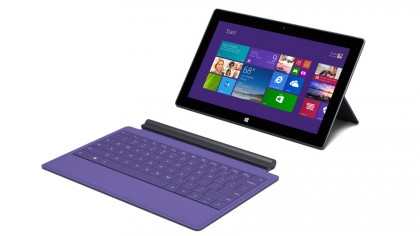
But then, it has Windows 8. Not the compromised RT version, you understand – I’m talking the full fat OS.
This means that any app or program you can install and run on your computer, you can run on the Surface Pro 2, while it looks at the Galaxy Note Pro 12.2’s attempts at multitasking and split-screen apps with a bemused smirk.
Put simply, if extreme professional productivity is your primary requirement, the Surface Pro 2 is tough to beat. If you also want some of the intuitive simplicity of a tablet and the Android OS, then the Galaxy Note Pro 12.2 might still get the nod.
The little brother
You might like the Samsung Galaxy Note Pro 12.2’s features, its S Pen stylus with attendant apps, and its strong camera. Heck, you might even like its design. But that size… that size…
What you need, sir or madam, is the Samsung Galaxy Note 10.1 2014. It’s effectively the little brother of the Samsung Galaxy Note Pro 12.2, with the same processor, the same camera – the same everything except for the size of its screen, which is a more normal 10.1-inch example.
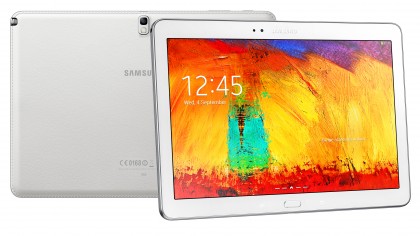
Did I say everything? The one snag here is that the Galaxy Note 10.1 runs on an older version of the Android OS and, more importantly, an older version of Samsung’s TouchWiz UI. It’s functionally similar, but not quite as nice to look at or use.
There’s a good chance this will get an update to the latest version, but there’s been no official announcement as yet.
Verdict
The Samsung Galaxy Note Pro 12.2 may be unwieldy, but by providing its S Pen stylus system with a 12.2-inch canvas on which to operate, it finally feels like the consistently useful productivity tool it always threatened to be.
Samsung still needs to work on its overall design and build quality standards if it’s to justify charging so much for a tablet, but it’s definitely onto something interesting here.
We liked
That extra 2.1 inches makes all the difference for productivity. It turns out that a 12.2-inch display unlocks the S Pen system’s full potential.
I also enjoyed the slight boost this extra screen space gave to a number of normal tablet functions, from movie watching to web browsing and even proper stereo sound separation.
Samsung’s latest UI modifications also represent a genuine progression from their previous cluttered efforts. It’s still not perfect, but it’s an improvement.
We disliked
The Galaxy Note Pro 12.2 doesn’t wear its extra inches lightly – this is as big and bulky as you might have feared, and holding it in one hand for any length of time is out of the question.
If Samsung has shown signs that it’s learning lessons in the field of software design, there’s no indication yet that it’s ready to join Apple, Nokia, and HTC at the top when it comes to premium hardware design. It just doesn’t look or feel like a £650 ($850, around AU$940) tablet.
Indeed, that price is perhaps the biggest snag of all – especially with such classy rivals in the same price category, or even cheaper.
Final verdict
As the first significant manufacturer to step forward with its vision of a super-sized tablet, Samsung has quite a job on its hands to convince the world that there is a genuine need, and that this isn’t just a gimmick.
If nothing else, the Samsung Galaxy Note Pro 12.2 successfully answers that question to the affirmative. It’s not a tablet you’ll want to lug around with you or whip out in public, and it is dauntingly expensive.
But if productivity is foremost in your mind as you shop for an Android tablet, the Galaxy Note Pro 12.2’s combination of huge HD display and S Pen interactivity is a compelling combination.
![]()











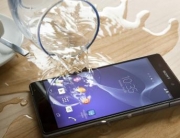

Leave A Comment